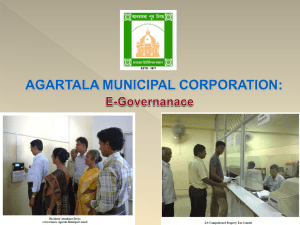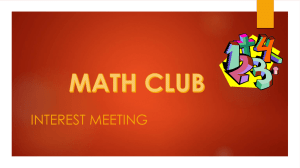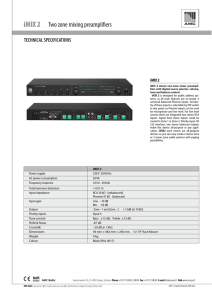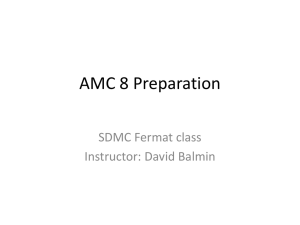AMC 8 Preparation
advertisement
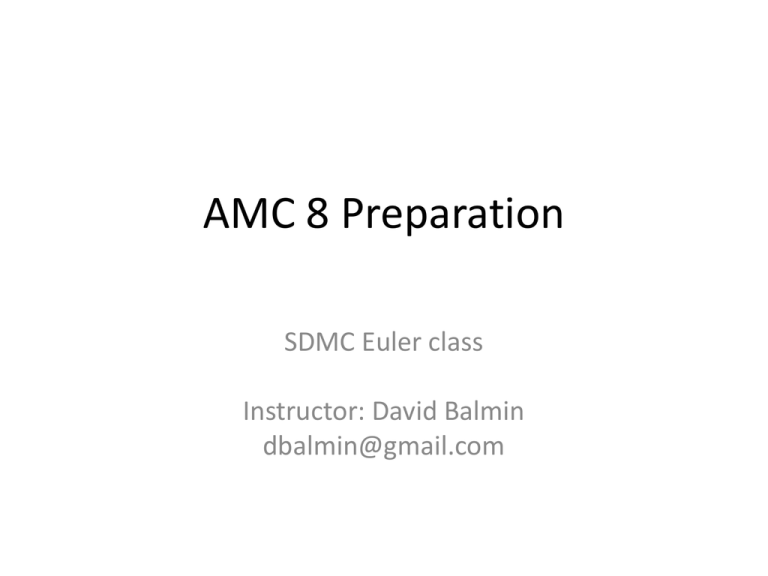
AMC 8 Preparation SDMC Euler class Instructor: David Balmin dbalmin@gmail.com Introduction • No calculators are allowed at AMC tests. • Approximately 10 first problems of each AMC 8 test can be solved without using pencil and paper. Introduction • Visit http://amc.maa.org: • “AMC Archives” –> “AMC 8” –> “Brochure Sample Questions” • Publications -> “AMC 8 Math Club Package 2009” with the large collection of AMC problems and solutions. Introduction • Practice to answer questions 1 through 15 of each test. • Try to solve these problems as fast as you can. • If you can consistently answer questions 1 through 15 correctly, concentrate on solving problems 16 through 25. Focus • We will focus in this class on solving several selected AMC 8 problems that are instructive and cover different topics. • We will start with reviewing some math theory and methods that can help you solve AMC 8 test problems. Permutations • Permutations – collections of n distinguishable objects arranged in different order. • For example: 1,2,3; 1,3,2; 2,3,1; 2,1,3; 3,2,1; 3,1,2 Permutations • The number of all different permutations of n objects is n! = 1*2*3*…*n. • We can prove it using the method of mathematical induction. Permutations • For n = 2, there are 2! = 2 permutations of 2 objects: 1,2 and 2,1. • If the number of all permutations of n-1 objects is (n-1)! and we add one more object to any permutation of n-1 objects, it can be inserted in any one of n places in it: #1, #2, …, #n. Permutations • While the new object is in any of n places, the number of permutations of n-1 other objects in their n-1 places is (n-1)! • Thus, the number of all different permutations of n objects equals (n-1)!*n = n! Combinations • Combinations – selections of k objects from n objects (the order of the objects in each selection is not important). • For example, any 3 students can be selected from 100 students in the auditorium to distribute materials. • In how many ways can such selections be made? Combinations • The total number of combinations of k objects from n objects, denoted C(n, k), is usually pronounced: “n choose k”. • How can we construct all combinations of k objects from n objects? • We can select the first k objects in each of n! permutations of n objects. Combinations • For each such selection, there are k! permutations of the first k objects and (n-k)! permutations of the remaining n-k objects. • k!*(n-k)! permutations per each combination. • C(n, k) = n!/(k!*(n-k)!) = n*(n-1)*…*(n-k+1)/k! • For example, C(100, 3) = 100*99*98/3! = 50*33*98. Combinations • Notice also that C(n, k) = C(n, (n-k)) for any whole numbers 0 <= k <= n. • This is intuitively clear since each collection of selected k objects out of n objects corresponds to exactly one collection of (n-k) not selected objects, and vice versa. Combinations • Also, by definition, C(n, 0) = 1. AMC 8 2010, Problem #25 • Every day at school, Jo climbs a flight of 6 stairs. Jo can take stairs 1, 2, or 3 at a time. For example, Jo can climb 3, then 1, then 2 stairs. In how many ways can Jo climb the stairs? (A) 13 (B) 18 (C) 20 (D) 22 (E) 24 AMC 8 2010, Problem #25 • The efficient method of solving this type of combinatorial problems is called “Stars and Bars”. • If we view 6 stairs as 6 “stars” and denote them (* * * * * *), we can also use the concept of dividers (“bars”) that can be placed in the gaps between any two adjacent “stars”. AMC 8 2010, Problem #25 • Let us ignore for a moment the condition that Jo can climb maximum 3 stairs and assume that Jo can climb any number of stairs, including all 6 stairs. • Then, we can easily calculate the numbers of combinations of positions of k bars out of total 5 positions (the gaps between 6 stars), where k = 0, 1, 2, 3, 4, 5. AMC 8 2010, Problem #25 • For example, (*|* *| * * *) represents the case when Jo has climbed 1, then 2, then 3 stairs. AMC 8 2010, Problem #25 • Combinations of k bars, where 0 <= k <= 5: C(5, 0) = 1 C(5, 1) = 5 C(5, 2) = 10 C(5, 3) = 10 C(5, 4) = 5 C(5, 5) = 1 AMC 8 2010, Problem #25 • The total number of all possible combinations of k bars positions, where 0 <= k <= 5: 32. • Now, we must subtract the numbers of combinations of bar positions that violate the condition that the number of contiguous stars cannot be greater than 3. AMC 8 2010, Problem #25 • C(5, 0) = 1 (* * * * * *) has 6 contiguous stars. This is invalid. We must count 1 invalid combination. • C(5, 1) = 5 (* * * | * * *) has only one valid combination. We must count 4 invalid combinations. AMC 8 2010, Problem #25 • C(5, 2) = 10 has 3 invalid combinations: (*|*|* * * *) (* * * *|*|*) (*|** * *|*) AMC 8 2010, Problem #25 • All the other combinations in the remaining three cases, C(5, 3), C(5, 4), and C(5, 5), are valid. • The total number of invalid combinations is 8. • Thus, the answer to the problem’s question is 32 – 8 = 24. Answer: (E). AMC 8 2005, Problem #19 AMC 8 2005, Problem #19 • Hint: side lengths 30 and 24 have common factor 6. • If we divide these two side lengths by 6, the similar right triangle with side lengths 5 and 4 will be 3-4-5 triangle. • So, the length of side AE is 3 * 6 = 18. AMC 8 2005, Problem #19 AMC 8 2005, Problem #19 Triangles Triangles Triangle Inequality Theorem Equilateral and Isosceles Triangles Right Triangles Right Triangles AMC 8 2005, Problem #9 AMC 8 2005, Problem #9 • Triangle ACD is isosceles. • Therefore, angles ACD and ADC have equal measures. • Triangle ACD is equilateral (60-60-60). • The length of AC = 17. • Answer (D). AMC 12 2011, Problem #13 • Triangle ABC has side-lengths AB = 12, BC = 24, and AC = 18. The line through the incenter of ∆ABC parallel to BC intersects AB at M and AC at N. What is the perimeter of ∆AMN? (A) 27 (B) 30 (C) 33 (D) 36 (E) 42 AMC 12 2011, Problem #13 AMC 12 2011, Problem #13 • Hint: The alternate interior angles between two parallel lines and a transversal line have equal measures. • So, ∠MOB = ∠OBC. • So, ∠MOB = ∠MBO. AMC 12 2011, Problem #13 • So, triangle OMB is isosceles. • MB = MO. • For the same reason, NC = NO. AMC 12 2011, Problem #13 • The perimeter of ∆AMN is: AM + AN + MN = AM + AN + MO + ON = = AB + AC = = 12 + 18 = 30. Answer: (B) Eratosthenes Eratosthenes • Circa 200 BC, the Greek mathematician Eratosthenes invented the brilliant method of measuring the circumference of Earth, based on his knowledge of geometry and astronomy. • His method is a good example of finding the “smart way” instead of the “hard way” to solve a difficult problem. Eratosthenes • As shown in the diagram, he needed to measure the angle φ between the two radii of the Earth pointing to the cities Alexandria and Syene in Egypt. Eratosthenes Eratosthenes • The direct (hard) way would have been to measure angle φ from the center of the Earth. • But the smart way that Eratosthenes invented was to measure the same angle φ between the sun ray and the lighthouse in Alexandria at noon time on the day of summer solstice, when the Sun was at the zenith in Syene. Eratosthenes • Using geometry of parallel lines, he calculated that the distance from Alexandria to Syene must be ≈ 7/360 of the total circumference of the Earth. Eratosthenes • The measurement of the distance between Alexandria and Syene was based on the estimated average speed of a caravan of camels that traveled this distance. • It is generally believed that Eratosthenes' value corresponds to between 39,690 km and 46,620 km., which is now measured at 40,008 km. Eratosthenes result is surprisingly accurate. Probability • • • • • Experiment Outcomes – Sample space Probability of the desired event: P The number of all possible outcomes: N The number of distinct ways (outcomes) the desired event can occur: M • P=M/N Probability – Example 1 • • • • Experiment: tossing a coin. All possible outcomes: heads or tails. The desired event: a coin landing on heads. Probability of the desired event: 1/2. Probability – Example 2 • • • • Experiment: throwing a dice with 6 faces. All possible outcomes: numbers 1 through 6. The desired event: an odd number. Probability of the desired event: 3/6 = 1/2. Probability – Example 3 Probability – Example 3 • Experiment: random shooting at the big circle. • All possible outcomes: hitting target anywhere inside the big circle. • The desired event: hitting target anywhere inside the small circle. • Probability of the desired event: Pi*1 / Pi*9 = 1/9. AMC 12A 2003, Problem #8 AMC 12A 2003, Problem #8 • All factors of 60: 1, 2, 3, 4, 5, 6, 10, 12, 15, 20, 30, 60. • The number of all factors is 12. AMC 12A 2003, Problem #8 • The number of all factors that are less than 7 is 6. • The probability: 6/12 = 1/2. • Answer: (E). AMC 12 2001, Problem #11 AMC 12 2001, Problem #11 • This problem illustrates the power of a smart transformation of the problem’s question to a different question that is easier to answer. AMC 12 2001, Problem #11 • The drawings can stop at drawing #2, drawing #3, or, “worst case”, drawing #4. • Suppose that we complete all 5 drawings, regardless of the results of the first 4 drawings. • We can define two mutually-exclusive results of the first 4 drawings: A and B. AMC 12 2001, Problem #11 • Result A: all the white chips have been drawn during the first 4 drawings. • Result B: all the red chips have been drawn during the first 4 drawings. • Then, the question in this problem can be rephrased as: “What is the probability of result A?” AMC 12 2001, Problem #11 • Result A is possible if and only if the remaining chip drawn in the 5th drawing is red. • Thus, the initial question in this problem can be further rephrased as: “What is the probability that the chip drawn in the 5th drawing is red?” AMC 12 2001, Problem #11 • The probability that the chip drawn in the 5th drawing is red equals 3/5. • Answer: (D). AMC 8 2010, Problem #20 AMC 8 2010, Problem #20 • First of all, we need to calculate the minimum number of people in the room. • The fractions 2/5 and 3/4 correspond to the numbers of people wearing gloves and hats respectively. • The minimum number of people in the room equals the least common denominator of these two fractions: 20. AMC 8 2010, Problem #20 • Now, we can calculate the number of people wearing gloves, 20 * 2/5 = 8, • and the number of people wearing hats, 20 * 3/4 = 15. • We can use the “worst case” method to answer the question of the problem. AMC 8 2010, Problem #20 • In the “best case”, 8 people wear both gloves and a hat, 7 people wear hats and no gloves, and 5 people wear neither gloves nor hats. • However, in the “worst case”, 3 people must wear both gloves and a hat; then 5 people wear gloves and no hats, and 12 people wear hats and no gloves. • Answer: (A). Speed-Distance-Time Problem • Two grandmas started travelling toward each other at dawn: first grandma from A to B and the other from B to A. Each grandma maintained steady speed during the entire trip. They met at noon and continued travelling without a pause. First grandma reached point B at 4 PM; the other grandma reached point A at 9 PM. What was the time of dawn that day? Speed-Distance-Time Problem Speed-Distance-Time Problem Speed-Distance-Time Problem Speed-Distance-Time Problem Speed-Distance-Time Problem Speed-Distance-Time Problem • X=6 • Answer: 6 am. AMC 8 2005, Problem #8 AMC 8 2005, Problem #8 • This is an example of how the multiple-choice answers can be used creatively. • Since we need to choose the formula that has odd values for all positive odd n and m, then one counter example for a given formula eliminates that formula. AMC 8 2005, Problem #8 • If we simply calculate each formula in A, B, C, D, and E for n = 1 and m = 1, then A, B, C, and D produce even numbers and can be eliminated. • Only the formula in answer E produces odd number that makes it the clear winner. • Answer: (E). AMC 8 2005, Problem #8 • Of course, it is not hard to solve this problem using the rules of math for odd and even numbers. • Whichever method works better for you during the test is fine, as long as it is correct. AMC 8 2005, Problem #24 AMC 8 2005, Problem #24 • Hint: start from the end and work backward. • Since the only available operations are “+1” and “*2”, the reverse operations are “-1” and “/2”. AMC 8 2005, Problem #24 • Clearly, we want to divide 200 by 2 and continue to repeat this operation as long as the result numbers are even. • We get numbers 100, 50, 25. • Since 25 is odd, the only choice is to subtract 1. We get 24. • Now, we can start dividing numbers by 2 again. We get numbers 12, 6, 3. AMC 8 2005, Problem #24 • 3 is odd. So, the last two reversed operations result in numbers 2 and 1. • Now, we can write the same numbers in the ascending order and count the forward operations: 1, 2, 3, 6, 12, 24, 25, 50, 100, 200. • The number of operations is 9. • Answer: (B) AMC 8 2005, Problem #24 • Prove that 8 operations suggested in answer (A) cannot result in 200. • If all 8 operations are “*2”: 2*2*2*2*2*2*2*2 = 256 > 200 • If we replace any one operation “*2” with “+1”: 3*64 = 192 < 200 AMC 8 2005, Problem #24 5*32 = 160 < 200 9*16 = 144 < 200 17*8 = 136 < 200 33*4 = 132 < 200 65*2 = 130 < 200 • It’s obvious that replacing the second “*2” operation with “+1” (after replacing the first one) will only reduce the final result. Factoring Problem In how many ways is it possible to factor number 36 into sets of three natural numbers (e.g., 1, 2, 18) ? Note: the order of factors in each set of three numbers is not important. (A) 8 (B) 9 (C) 10 (D) 12 (E) 15 Factoring Problem • The factors of 36 are: 1, 2, 3, 4, 6, 9, 12, 18, 36 . Factoring Problem • There are 5 distinct pairs of factors of 36: (1, 36) (2, 18) (3, 12) (4, 9) (6, 6) Factoring Problem 1=1*1 2=1*2 3=1*3 4=1*4 4=2*2 6=1*6 6=2*3 (1 * 1 * 36 = 36) (1 * 2 * 18 = 36) (1 * 3 * 12 = 36) (1 * 4 * 9 = 36) (2 * 2 * 9 = 36) (1 * 6 * 6 = 36) (2 * 3 * 6 = 36) Factoring Problem • 9=3*3 (4 * 3 * 3 = 36) • The total number of sets of three factors of 36 is 8. • Answer: (A) AMC 12A 2006, Problem #25 AMC 12A 2006, Problem #25 • The common sum must be odd since 44 and 38 are even and all prime numbers (except 2) are odd. • 59 is odd. Therefore, its prime number is 2. • The common sum is 59 +2 = 61. AMC 12A 2006, Problem #25 • Two others primes are 61 – 44 = 17 and 61 – 38 = 23. • The average of primes is (2+17+23)/3 = 14 • Answer: (B) AMC 12A 2006, Problem #23 AMC 12A 2006, Problem #23 • After dividing among 6 people, 4 coins are left. Add 2 coins to make the total divisible by 6. • After dividing among 5 people, 3 coins are left. Again, add 2 coins to make the total divisible by 5. • The LCM of 6 and 5 is 30. AMC 12A 2006, Problem #23 • The number of coins in the box is 30 - 2 = 28. • 28 is divisible by 7. • Answer: (A). AMC 12A 2002, Problem #21 Consider the sequence of numbers: 4, 7, 1, 8, 9, 7, 6, …. For n > 2, the nth term of the sequence is the units digits of the sum of the two previous terms. Let denote the sum of the first n terms of this sequence. The smallest value of n for which > 10,000 is: (A) 1992 (B) 1999 (C) 2001 (D) 2002 (E) 2004 AMC 12A 2002, Problem #21 • 4, 7, 1, 8, 9, 7, 6, 3, 9, 2, 1, 3, 4, 7. • The sum of the first 12 members is 60. • If we divide 10,000 by 60: 166 complete 12-blocks of members. AMC 12A 2002, Problem #21 • 166 * 60 = 9,960 = 10,000 - 40 • 4+7+1+8+9+7 = 36 < 40 (6 members) • 4+7+1+8+9+7+6 = 42 > 40 (7 members) • 166*12 + 7 = 1,999 • Answer: (B)
